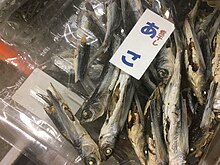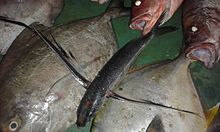Flying fish
| Flying fish Temporal range:
| |
|---|---|

| |
| Sailfin flying-fish,Parexocoetus brachypterus | |
| Scientific classification | |
| Domain: | Eukaryota |
| Kingdom: | Animalia |
| Phylum: | Chordata |
| Class: | Actinopterygii |
| Order: | Beloniformes |
| Suborder: | Exocoetoidei |
| Superfamily: | Exocoetoidea |
| Family: | Exocoetidae Risso,1827[2] |
| Genera | |
|
See text | |
TheExocoetidaeare afamilyofmarineray-finned fishin theorderBeloniformes,known colloquially asflying fishorflying cod.About 64speciesare grouped in sevengenera.While they cannot fly in the same way a bird does, flying fish can make powerful, self-propelled leaps out of the water where their long wing-like fins enableglidingfor considerable distances above the water's surface. The main reason for this behavior is thought to be to escape from underwater predators,[3][4][5]which includeswordfish,mackerel,tuna,andmarlin,among others,[6]though their periods of flight expose them to attack by avian predators such asfrigate birds.
Barbadosis known as "the land of the flying fish" and the fish is one of the national symbols of the country. TheExocetmissile is named after them, as variants are launched from underwater, and take a low trajectory, skimming the surface, before striking their targets.
Etymology[edit]
The termExocoetidaeis both the scientific name and the general name inLatinfor a flying fish. The suffix-idae,common for indicating a family, follows the root of the Latin wordexocoetus,a transliteration of theAncient Greeknameἐξώκοιτος.This means literally 'sleeping outside', fromἔξω,'outside', andκοῖτος,'bed', 'resting place', with the verb rootκει-,'to lie down' (not 'untruth'),[7]so named as flying fish were believed to leave the water to sleep ashore,[8]or due to flying fish flying and thus stranding themselves in boats.
Taxonomy[edit]
The Exocoetidae is divided into foursubfamiliesand seven genera:[2][9][10]
- SubfamilyExocoetinae(Risso,1827)
- SubfamilyFodiatorinae(Fowler,1925)
- GenusFodiator(D.S. Jordan&Meek,1885)
- SubfamilyParexocoetinae(Bruun,1935)
- GenusParexocoetus(Bleeker,1865)
- SubfamilyCypsellurinae(Hubbs,1933)
- GenusCheilopogon(Lowe,1841)
- GenusCypselurus(Swainson,1838)
- GenusHirundichthys(Breder,1928)
- GenusPrognichthys(Breder, 1928)
Distribution and description[edit]


Flying fish live in all of theoceans,particularly intropicaland warmsubtropicalwaters. They are commonly found in theepipelagic zone,the top layer of the ocean to a depth of about 200 m (660 ft).
Numerous morphological features give flying fish the ability to leap above the surface of the ocean. One such feature is fully broadenedneural arches,which act as insertion sites forconnective tissuesand ligaments in a fish's skeleton. Fully broadened neural arches act as more stable and sturdier sites for these connections, creating a strong link between thevertebral columnandcranium.[11]A steady glide will improve their flight duration and allow them to be above water. An unsteady glide will not impact their flight as much but will shorten their flight duration not much more than a steady flight. This also will vary based on their energy consumption.[12]This ultimately allows a rigid and sturdy vertebral column (body) that is beneficial in flight. Having a rigid body during glided flight gives the flying fishaerodynamicadvantages, increasing its speed and improving its aim.[11]Furthermore, flying fish have developedvertebral columnsandossifiedcaudalcomplexes.[13]These features provide the majority of strength to the flying fish, allowing them to physically lift their bodies out of water and glide remarkable distances. These additions also reduce the flexibility of the flying fish, allowing them to perform powerful leaps without weakening midair.[13]At the end of a glide, they fold theirpectoral finsto re-enter the sea, or drop their tails into the water to push against the water to lift for another glide, possibly changing direction.[14][15]The curved profile of the "wing" is comparable to the aerodynamic shape of a bird wing.[16]The fish is able to increase its time in the air by flying straight into or at an angle to the direction ofupdraftscreated by a combination ofairandocean currents.[14][15]
Species of genusExocoetushave one pair of fins and streamlined bodies to optimize for speed, whileCypselurusspp. have flattened bodies and two pairs of fins, which maximize their time in the air. From 1900 to the 1930s, flying fish were studied as possible models used to develop airplanes.[15]
The Exocoetidae feed mainly onplankton.Predators includedolphins,tuna,marlin,birds,squid,andporpoises.[15]
Flight measurements[edit]
In May 2008, a Japanese television crew (NHK) filmed a flying fish (dubbed "Icarfish" ) off the coast ofYakushima Island,Japan. The fish spent 45 seconds in flight.[17]The previous record was 42 seconds.[17]
The flights of flying fish are typically around 50 m (160 ft),[18]though they can use updrafts at the leading edge of waves to cover distances up to 400 m (1,300 ft).[18][19]They can travel at speeds of more than 70 km/h (43 mph).[15]Maximum altitude is 6 m (20 ft) above the surface of the sea.[16]Flying fish often accidentally land on the decks of smaller vessels.[15][20][21]
Fishery and cuisine[edit]


Flying fish are commercially fished inJapan,Vietnam,andChinabygillnetting,and inIndonesiaandIndiabydipnetting.[15]Often inJapanese cuisine,the fish is preserved by drying to be used asfish stockfordashibroth. TheroeofCheilopogon agoo,or Japanese flying fish, is used to make some types ofsushi,and is known astobiko.It is also a staple in the diet of theTao peopleofOrchid Island,Taiwan.Flying fish is part of the national dish of Barbados,cou-couand flying fish. The taste is close to that of a sardine.
Flying fish roe is known as "cau-cau" in southern Peru, and is used to make several local dishes.[citation needed]
In theSolomon Islands,the fish are caught while they are flying, using nets held fromoutrigger canoes.They are attracted to the light of torches. Fishing is done only when no moonlight is available.[citation needed]
Importance[edit]
Barbados[edit]

Barbadosis known as "the land of the flying fish", and the fish is one of the national symbols of the country. Once abundant, itmigratedbetween the warm,coral-filledAtlantic Oceansurrounding the island of Barbados and the plankton-rich outflows of theOrinocoRiver inVenezuela.[citation needed]
Just after the completion of theBridgetown Harbor / Deep Water Harborin Bridgetown, Barbados had an increase of ship visits, linking the island to the world. The overall health of thecoral reefssurrounding Barbados suffered due to ship-basedpollution.Additionally, Barbadianoverfishingpushed them closer to the Orinocodelta,no longer returning to Barbados in large numbers. Today, the flying fish onlymigrateas far north asTobago,around 120 nmi (220 km; 140 mi) southwest of Barbados. Despite the change, flying fish remain a coveted delicacy.[citation needed]
Many aspects of Barbadian culture center around the flying fish; it is depicted on coins, as sculptures in fountains, in artwork, and as part of the official logo of the Barbados Tourism Authority. Additionally, theBarbadian coat of armsfeatures apelicananddolphinfishon either side of the shield, but the dolphinfish resembles a flying fish. Furthermore, actual artistic renditions andhologramsof the flying fish are also present within theBarbadian passport.[citation needed]
Maritime disputes[edit]
Flying fish have also been gaining in popularity in other islands, fueling several maritime disputes. In 2006, the council of theUnited Nations Convention on the Law of the Sea[22]fixed themaritime boundariesbetweenBarbadosandTrinidad and Tobagoover the flying fish dispute, which gradually raised tensions between the neighbours.[23]The ruling stated both countries must preserve stocks for the future. Barbadian fishers still follow the flying fish southward.
Indonesia[edit]
Makassarfishermen in southSulawesihave been catching flying fish (torani) in special boats calledpatoranifor centuries developing their own sailing traditions along the way. These fishermen were able to sail as far asKimberleyregion in west of Australiareaching the indigenous peoplethere.[24]
Prehistoric analogues[edit]
The oldest known fossil of a flying or gliding fish are those of the extinct familyThoracopteridae,dating back to theMiddle Triassic,235–242 million years ago.[25]However, they are thought to be basalneopterygiansand are not related to modern flying fish, with the wing-like pectoral fins beingconvergently evolvedin both lineages.[26]Similarly, theCheirothricidaeof theLate Cretaceousalso similarly evolved wing-like pectoral fins that were likely also used for gliding, but are indeterminateeurypterygians;they are possiblyAulopiformes,which would make them most closely related tolizardfish.[27]
See also[edit]
References[edit]
- ^Fossilworks."Exocoetidae".
- ^abRichard van der Laan; William N. Eschmeyer & Ronald Fricke (2014)."Family-group names of Recent fishes".Zootaxa.3882(2): 001–230.doi:10.11646/zootaxa.3882.1.1.PMID25543675.
- ^"Recent Discoveries about the Evolution of Flying Fish | Bio-Aerial Locomotion".Retrieved2019-09-01.
- ^Davenport, John (June 1994). "How and why do flying fish fly?".Reviews in Fish Biology and Fisheries.4(2): 184–214.Bibcode:1994RFBF....4..184D.doi:10.1007/BF00044128.S2CID34720887.
- ^"Flying Fish | National Geographic".Animals.2010-04-11. Archived fromthe originalon July 2, 2017.Retrieved2019-09-01.
- ^Cy Berlowitz (2016).Sealights.Lulu.com. p. 32.ISBN9781365061417.
- ^Harper, Douglas."exocet".Online Etymology Dictionary.
- ^Pliny'sNatural History,vol. IX, chapter 34
- ^J. S. Nelson; T. C. Grande; M. V. H. Wilson (2016).Fishes of the World(5th ed.). Wiley. p. 366.ISBN978-1-118-34233-6.Archived fromthe originalon 2019-04-08.Retrieved2020-01-10.
- ^Eschmeyer, William N.;Fricke, Ron & van der Laan, Richard (eds.)."Genera in the family Exocoetidae".Catalog of Fishes.California Academy of Sciences.Retrieved15 August2019.
- ^abDasilao, Juanito C.; Yamaoka, Kosaku (September 1998). "Development of the vertebral column and caudal complex in a flyingfish,Parexocoetus mento mento (Teleostei: Exocoetidae)".Ichthyological Research.45(3): 303–308.Bibcode:1998IchtR..45..303D.doi:10.1007/BF02673928.S2CID33251544.
- ^Kawachi, K., Inada, Y., & Azuma, A. (1993).Optimal Flight Path of Flying Fish
- ^abDasilao, Juanito C.; Sasaki, Kunio (January 1998). "Phylogeny of the flyingfish family Exocoetidae (Teleostei, Beloniformes)".Ichthyological Research.45(4): 347–353.Bibcode:1998IchtR..45..347D.doi:10.1007/BF02725187.S2CID24966029.
- ^abFish, F. E. (July 1990). "Wing design and scaling of flying fish with regard to flight performance".Journal of Zoology.221(3): 391–403.doi:10.1111/j.1469-7998.1990.tb04009.x.
- ^abcdefgKutschera, U. (2005)."Predator-driven macroevolution in flyingfishes inferred from behavioural studies: historical controversies and a hypothesis"(PDF).Annals of the History and Philosophy of Biology.10:59–77. Archived fromthe original(PDF)on 2007-08-20.
- ^abFish, F. (1991)."On a fin and a prayer"(PDF).Scholars.3(1): 4–7. Archived fromthe original(PDF)on 2013-11-02.
- ^ab"Fast flying fish glides by ferry".BBC News.May 20, 2008.RetrievedMay 20,2008.
- ^abRoss Piper(2007),Extraordinary Animals: An Encyclopedia of Curious and Unusual Animals,Greenwood Press.[page needed]
- ^"Flying Fish".National Geographic.11 April 2010. Archived fromthe originalon February 28, 2021.
- ^Joseph Banks (1997).The Endeavour Journal of Sir Joseph Banks 1768–1771(PDF).University of Sydney Library.RetrievedJuly 16,2009.
- ^Moran.Churchill: Taken from the Diaries of Lord Moran.p. 819.
- ^"Barbados/Trinidad and Tobago".Permanent Court of Arbitration.April 11, 2006. Archived fromthe originalon 2010-06-02.
- ^"Claims of Caribbean piracy as national symbol takes flight".The Sydney Morning Herald.December 18, 2004.
- ^Demmallino, Eymal B.; M. Saleh S. Ali (2018)."Patorani: Occultness, religiosity, and environmentally friendly technology of the flying fish hunters".Journal of Asian Rural Studies.2(1): 73–84.doi:10.20956/jars.v2i1.1366.
- ^Subbaraman, Nidhi (31 October 2012). "Oldest flying fish fossil found in China".Nature.doi:10.1038/nature.2012.11707.S2CID131398231.
- ^Xu, Guang-Hui; Zhao, Li-Jun; Gao, Ke-Qin; Wu, Fei-Xiang (7 January 2013)."A new stem-neopterygian fish from the Middle Triassic of China shows the earliest over-water gliding strategy of the vertebrates".Proceedings of the Royal Society B: Biological Sciences.280(1750): 20122261.doi:10.1098/rspb.2012.2261.PMC3574442.PMID23118437.
- ^Dietze, Kathrin (2009-06-01)."Morphology and phylogenetic relationships of certain neoteleostean fishes from the Upper Cretaceous of Sendenhorst, Germany".Cretaceous Research.30(3): 559–574.Bibcode:2009CrRes..30..559D.doi:10.1016/j.cretres.2008.11.001.ISSN0195-6671.



